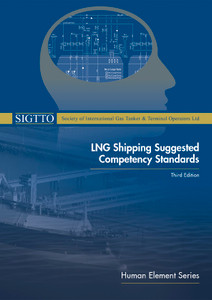
This publication charts the history of LNG transportation by sea, from the early tank and ship designs to the development of membranes and spheres. It discusses the involvement of IMO and Classification Societies and offers a look ahead to the potential future developments within the LNG industry.
Natural Gas by Sea is a comprehensive look at the history of LNG and how, within a relatively short time span, it became a well-established, highly sophisticated and safe branch of modern marine engineering. The book outlines this development in detail, before going on to cover the legislative processes behind the shipping of LNG, as well as what the future of LNG could look like.
Forty years ago the first attempts were made to find the materials, and to
establish practical design and building techniques, for shipping liquefied natural
gas (LNG) at its boiling point of minus 165º Centigrade safely across the oceans
of the world in commercial quantities.
Many experts pronounced it impossible — or dangerous — or both, but the
perseverance of a small team of engineers in the U.S.A., encouraged by the
British Gas Industry, proved that it was at once possible, safe and commercially
viable.
Europe accepted the challenge and developed their own technology which
was to compete with, and quickly over-take, the U.S.A. in the race to participate
in this new and potentially lucrative trade.
The book describes the way in which this fascinating new technology
was developed and how, within a relatively short time span, it became a
well established, highly sophisticated and safe, branch of modern marine
engineering; ships of up to 135,000 m3 capacity and, for their size, the most
expensive merchant ships afloat, are now in regular service worldwide. Indeed,
today it is quite difficult to conceive of life without LNG. No small part of the
fascination of this story is the atmosphere of commercial secrecy in which the
technology grew and prospered, and the wide variety of designs which has
evolved.
The technology is still developing and the trade expanding. This new edition
brings the reader up to date and offers an ‘educated guess’ as to what the future
might have in store.
Chart: Periods covered by Chapters and Some Landmarks
1. How it All Started
2. First Attempts at a Solution
3. Wide Participation and Further Testwork in the USA
4. Activities Outside the USA
5. The Role of the Classification Societies
6. The First Prototype — Methane Pioneer
7. The Second Prototype — Beauvais
8. Cargo Handling Arrangements
9. The First Commercial LNG Ships
10. Patents and Politics
11. Membranes — Breakthrough?
12. Two More Projects and a Speculative Ship
13. The Spheres
14. Market Prospects Generate Many New Designs
15. The IMO Code
16. A Decade of Consolidation
17. Projects Past, Present and Future
18. A Look Ahead
Appendices
1 What is Natural Gas?
2 Some Approximate Physical Properties of Constituents of Natural Gas
3 US Coast Guard Tentative Standards for Transportation of Liquefied Inflammable Gases at Atmospheric Pressure (August 22, 1956)
4a/4b Lighter moments at the Gastech Conferences
5 SIGTTO Publications Relating to LNG
The late Roger Ffooks, B.Sc., F.R.I.N.A. was involved with gas tankers, both LNG and LPG, since the early 1950s, first as senior Naval Architect with Shell International Marine Limited and subsequently as Technical Director of Conch Methane Services Limited.
He was directly concerned with the design, construction and operation of ‘Methane Princess’ and ‘Methane Process’, the first two commercial LNG carriers, and subsequently the development of one of the two basic membrane designs. He contributed to the preparation of the IMO Gas Carrier Code as representative of the International Chamber of Shipping and the British Delegation and wrote a number of papers on LNG ship design and development.
- Number of Pages:
- 245
- ISBN:
- 9781856090520
- Published Date:
- January 1993
- Binding Format:
- Hardback
- Book Height:
- 245 mm
- Book Width:
- 170 mm
- Weight:
- 1.2 kg
- Author:
Roger Ffooks
- Preview:
- Yes





